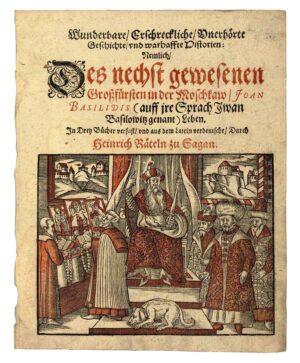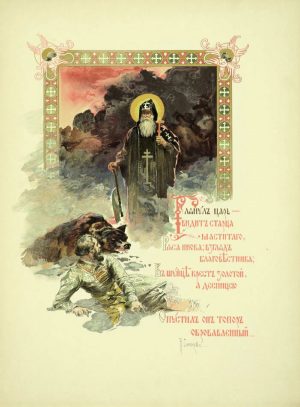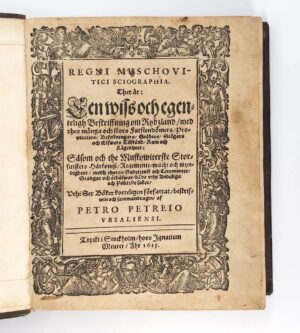Our Notes & References
The first biography of Ivan the Terrible and “the first biography of a Russian monarch to be printed in Europe” (Filiushkin): a pleasant example of one of the earliest European accounts of Russia.
The Lutheran pastor and missionary in Livonia Paul Oderborn (c.1555-1604) wrote this famous work about Ivan IV, also known as Ivan the Terrible (1530-84), shortly after the tsar’s death and the end of the Livonian war (1558-82). Oderborn had not been to Muscovy himself and based his work on reports of statesmen, eyewitness accounts of diplomats, military officers, defectors and prisoners of war, descriptions of battles and his own moral teachings. This magnum opus by Oderborn, who evidenced the aftermath of the war in his homeland, is written “with obvious partiality, perhaps even exaggeration” (Adelung, our translation here and elsewhere). The author describes Ivan’s reign as a series of atrocities and himself as “the greatest criminal among rulers and tyrants”, adding that: “a sovereign who cannot govern his own country cannot even dream of consolidating his power in foreign states”.
The book consists of three parts: first, a geographical overview of Russia and the stipulations on the “inheritance” received by Ivan IV from his “immoral” parents: his hereditary tyrannical qualities which were already evident in his young years. The second part lists all of his “tyranny”, both in relation to the neighbouring nations (his campaigns to the East and Livonia) and in relation to his own subjects (‘oprichnina’, the sack of Novgorod). The third part, the largest in volume, characterises the retribution for the tsar’s sins: the murder of his son, the plague, raids of the Tatars, a comet in 1584, and a dishonourable death. In conclusion and in contrast, Oderborn creates a literary portrait of Ivan’s son Fedor (1557-98), a kind, gentle and wise sovereign and a direct antithesis of the tyrant.
Some of the rumours and legends included in the book are especially peculiar, such as the story of the “Lukomorets” people who periodically die and resurrect in central Russia. Some are partially true though, such as the rebellion of women in Moscow after the capture of Polotsk: after learning about the failures at the front, the women “flooded the whole city of Moscow with weeping and screaming, and demanded the authorities to return their husbands home, or to give them the new ones” (Polosin). Oderborn’s details about the Livonian War are surprisingly accurate, with the exact dates, the names of the captives, and a detailed account of the Treaty of Yam-Zapolsky.
Inspired by Renaissance literature, Oderborn gives a particularly eloquent and psychologically appealing description of Ivan’s anguish at the sight of his dying son: “there the father, turning to his wounded but still breathing son immediately went from anger to remorse, raised his hands to heaven, began to utter complaints and sobs, then saying goodbye, then comforting the lying man, then lamenting his fate, then accusing the gods who had plunged such a dear creature into this evil […] He sat there on the floor like a madman, did not want to accept neither food nor drink and never took off his mourning dress again”.
Oderborn nonetheless credits Ivan’s administrative attempts to eliminate abuses in the state apparatus; he notes his impressive physique: “tall, strong, sturdy, well-proportioned” with “a remarkable gift for irony and sarcasm, [..] a sharp mind and excellent memory”. The compliments are quickly outweighed by the comments about his vanity: he “craved glory so much that he started a grievous war just because of it”, and violence: the tsar loved to play chess and cards, but in case of defeat, he would cut his competitors’ ears, noses and lips, and killed those who did not want to play with him.
Oderborn’s book had a great influence, and his descriptions and anecdotes were popularised by later scholars and observers of Russia. Nikolai Karamzin shared Oderborn’s views on Ivan IV and quoted him abundantly in his famous History of the Russian State. In the Tales of Foreigners about the Moscow State, Vasilii Kliuchevskii used Oderborn’s testimony both to characterise the cruelties of the tsar and to present a history of Veliky Novgorod. This valuable collection of foreign opinions, reviews, and gossip about sixteenth-century Russia is altogether an important source “on the intellectual history of the era, the history of political propaganda and socio-cultural discourses of the German lands and the Polish-Lithuanian Commonwealth at the end of the 16th century” (Filiushkin).
The book was first published in 1585 in Latin as Ioannis Basilidis Magni Moscoviae Ducis vita, and soon in German with edits and additions in 1588 and 1589. This copy belongs to the third German edition, and the last of th 16th century. Next editions appeared only in 1698 and 1842.
All three first German editions have a lovely colour woodcut on the title showing three images: the Mother of God, John the Baptist, and… an archbishop (sometimes described as the Pope of Rome) to the right of the enthroned Ivan IV — Lutheran Oderborn’s deliberate mockery of the Christian Orthodox tsar who denounced Catholicism and viewed protestants as “heretics and schismatics par excellence” (Ivanov).
All early editions are scarce: WorldCat doesn’t show any example of this one in the US nor in the UK, and we could trace only two other copies at auction in recent decades (none in the past 13 years).
Provenance
Martin E. Winkler (1893–1982, a noted German scholar and icon collector; bookplate on upper endpaper); Pr. Philip Longworth (1933-2020, historian, writer and book collector, esp. on Russian history; acquired at Christie’s London, 30 Nov. 2010, lot 366).
Bibliography
Cat. Russica O-155; cf. Rovinskii, Slovar’ gravirovannikh portretov II, pp.1022-3; Russia Engages the World, p.188 (the Latin edition); Adelung I, 91 (the Latin edition)
A. I. Filiushkin, “Antigeroi evropy: kak sozdavalas ‘Ioannis Basilidis Magni Moscoviae Ducis vita’ Paula Oderborna” // Drevniaia Rus. Voprosy Medievistiki, 2023, #2 (92), pp. 109—125.
Ivanov, Audrey V. “Reformation and the Muscovite Czar: Anti-Protestant Polemic in the Writings of Ivan the Terrible” // The Sixteenth Century Journal, vol. 40, no. 4, 2009, pp. 1109–29.
Polosin I. I., “Nemetskii pastor Oderborn i ego pamflet ob Ivane Groznom (1585)” // Sotsialno-politicheskaia istoriia Rossii XVI – nach. XVII vv., Moskva, 1968.
Physical Description
Quarto (18.7 x 14.5 cm). [116] ll., incl. title printed in red and black with large illustration also in red and black.
Binding
Later (17-18th-c.) German calf spine with raised bands and gilt fillets over sprinkled boards, edges sprinkled red.
Condition
Binding a bit rubbed, hinges more worn, with minimal losses, but solid; text leaves a bit brown and with the odd spot, occasional light coloured pencil underlining, about the second half with larger dampstain, mostly faint, more visible towards the end; still a pleasant example.









